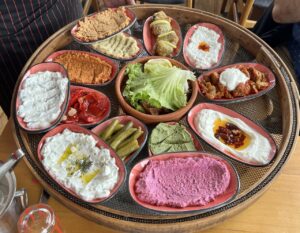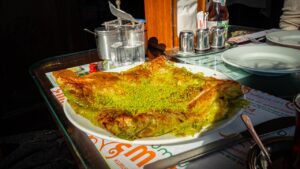Known as the bridge between Europe and Asia, Istanbul’s food scene is shaped by history, making Food Tours Istanbul a unique way to explore these flavors. The Ottoman Empire, which spanned over 600 years, left a lasting influence on the city’s cuisine. During that time, Ottoman cooks blended spices, herbs, and ingredients from all over the empire, creating dishes that are still beloved today. This history is alive in every kebab, every plate of rice pilaf, and every piece of baklava enjoyed in Istanbul. Tasting these dishes offers a connection to centuries-old culinary traditions.
While dishes like kebabs and Turkish delight are famous worldwide, there’s much more to discover in Istanbul’s cuisine. The city’s food culture includes ingredients brought from regions that once formed the Ottoman Empire, including spices, fruits, and grains. These ingredients and the techniques passed down from Ottoman kitchens give Istanbul’s food its unique character. From savory meats seasoned with sumac to desserts made with honey and pistachios, each bite carries a hint of the empire’s legacy, and Food Tours Istanbul offers an ideal way to explore it.
For visitors wanting to truly experience Istanbul’s culinary heritage, a food tour in Istanbul provides a guided journey through Ottoman-inspired dishes, traditional recipes, and the flavors that define the city. It’s a journey through Istanbul’s past, one delicious bite at a time.
The Ottoman Empire: A Glance at History and Legacy
The Ottoman Empire was one of the world’s most powerful and long-lasting empires. It began in 1299 and continued for over 600 years, lasting until the early 20th century. At its peak, the Ottoman Empire covered a vast area across three continents—spanning parts of Southeast Europe, Western Asia, North Africa, and the Arabian Peninsula. This vast reach helped the empire bring together people, ideas, and cultures from many different backgrounds, which had a big impact on daily life, including food. Food Tours Istanbul highlights these influences, connecting modern tastes with this rich legacy.
The Ottoman Empire’s economy was strong, largely based on trade and agriculture. With its central location between Europe and Asia, the empire controlled major trade routes, including the Silk Road, which allowed goods to flow in from far and wide. Istanbul’s markets were filled with spices, textiles, and other goods from across the world, making it one of the busiest trading hubs of its time. This trade shaped not only the empire’s wealth but also the way people lived, ate, and interacted with each other.
Religion played a central role in the Ottoman Empire’s structure. While the empire was officially Islamic, it allowed religious diversity, welcoming communities of Christians, Jews, and other faiths. This openness led to a rich cultural mix, as people from different backgrounds lived and worked side by side. This diversity influenced art, architecture, and, of course, food. Many of the dishes enjoyed today in Istanbul were inspired by the shared traditions and ingredients from these various communities.

Istanbul’s Culinary Heritage: The Influence of the Ottoman Empire
The food culture in Istanbul is a direct result of the Ottoman Empire’s vast influence. For centuries, Ottoman chefs experimented with ingredients, spices, and cooking methods gathered from the empire’s extensive territories. From Europe to Asia and North Africa, each region brought unique flavors that blended together in the kitchens of Istanbul. This mix of influences created a food culture that is distinctively Turkish but with traces of many cultures, each adding its own taste to the table. Food Tours Istanbul brings these flavors to life, showcasing dishes rooted in Ottoman heritage.
During Ottoman times, cooking was a respected art form. The sultans’ kitchens were staffed with skilled chefs who crafted elaborate meals for the palace. These chefs developed recipes that used spices, fruits, and nuts from across the empire, combining flavors in ways that were new and exciting. Dishes like kebabs and pilafs became popular, blending rich meats with aromatic spices and grains. These dishes are still popular today, and many of them remain central to Istanbul’s cuisine, reminding people of their long history.
One of the key characteristics of Ottoman cuisine was the use of spices. Chefs didn’t just use spices for heat; they carefully layered flavors to create depth. Ingredients like cinnamon, allspice, and sumac became staples, giving each dish a unique taste. This use of spices, combined with fresh ingredients, created flavors that were both complex and balanced, something that continues in Turkish cooking today.

Signature Ingredients from Ottoman Kitchens
The Ottoman Empire brought together a rich variety of ingredients from across its vast territories, creating a pantry full of flavors that are still part of Turkish cuisine today. These ingredients came from different regions, each adding its own taste and texture to the dishes crafted in Istanbul’s kitchens. Even today, local markets are filled with these flavors, giving visitors a taste of the empire’s culinary legacy on Food Tours Istanbul.
Some of the most commonly used ingredients include spices like saffron, sumac, and cinnamon, which give Turkish dishes their distinctive taste. Saffron, a precious spice often used in rice dishes, adds a rich color and subtle flavor. Sumac, with its tangy taste, is often sprinkled on salads or grilled meats to give a hint of sourness that balances out the other flavors. Cinnamon, used in both sweet and savory dishes, is another spice that brings warmth to many traditional meals.
Fruits and nuts also play an important role in Istanbul’s cuisine, reflecting the Ottoman love for combining sweet and savory. Dried fruits like apricots, figs, and dates add natural sweetness to dishes, while nuts like pistachios, almonds, and walnuts bring a satisfying crunch. These ingredients are often used in both main dishes and desserts, creating a unique balance of flavors. For instance, you’ll find dried fruits paired with meats or nuts mixed into rice pilaf, adding layers of taste and texture to each bite.

Food Tours Istanbul Takes You to Try Ottoman Dishes on Today’s Table
One of the most iconic dishes with Ottoman roots is the kebab. Known for its savory, grilled meat, the kebab became popular in the empire’s royal kitchens and eventually spread across the empire. Today, Istanbul’s kebabs come in many forms—whether skewered, wrapped in bread, or served with rice. Each style reflects a blend of spices and techniques that have been perfected over centuries, making kebabs a must-try on any Food Tours Istanbul experience.
Rice pilaf is another classic dish from the Ottoman era. In Ottoman kitchens, rice was often cooked with rich flavors, including spices, nuts, and sometimes dried fruits, creating a dish that was both filling and flavorful. Pilaf remains a staple in Istanbul, with variations that showcase different ingredients and regional influences. This simple yet flavorful dish is often served alongside meats or vegetables, adding a comforting element to Turkish meals.
Stuffed vegetables, or dolma, are another popular Ottoman-inspired dish that visitors can taste on a food tour. This dish involves stuffing vegetables like peppers, tomatoes, or grape leaves with a mixture of rice, herbs, and sometimes meat. Dolma combines the empire’s love for fresh herbs and spices, creating a dish that’s both flavorful and satisfying. These dishes, from kebabs to pilaf and dolma, showcase the creativity of Ottoman chefs and the legacy that continues to enrich Istanbul’s food culture today.

Spices and Sweets: A Lasting Legacy
The Ottomans loved using spices, not just to add flavor but to create depth and balance in their dishes. Spices like cinnamon, allspice, and cloves found their way into many recipes, giving Turkish cuisine its unique, layered taste. These spices weren’t just for savory dishes—sweet treats in Ottoman times also featured these warm, fragrant flavors, making Turkish sweets a memorable part of the food experience in Istanbul today. Food Tours Istanbul allows guests to sample these iconic sweets, bringing the past to life.
One of the most famous desserts with Ottoman roots is baklava, a rich pastry made with layers of thin dough, nuts, and honey or syrup. Baklava became popular in the empire’s palaces and remains a favorite in Turkish cuisine. The nuts used in baklava, like pistachios or walnuts, add texture, while the syrup or honey gives each bite its sweet, sticky richness. Istanbul’s baklava shops still follow traditional methods to make this dessert, creating flavors that have been loved for generations.
If you’re interested in Istanbul culture and want to read more about it, check out our article on the art of Turkish coffee.
Experience the Legacy – Book Food Tours Istanbul
Experiencing Istanbul’s food is like taking a journey through its history, with each dish offering a taste of the city’s past. A food tour in Istanbul is the perfect way to connect with the city’s heritage. Guided by locals who know the ins and outs of Turkish cuisine, visitors get to sample iconic dishes with deep roots in Ottoman history.
If you’re ready to explore Istanbul’s food scene and discover the flavors of the Ottoman legacy, book our food tours in Istanbul. It’s a chance to taste history, connect with locals, and enjoy the best of Istanbul’s culinary traditions. Let this food tour be your guide to an unforgettable experience in one of the world’s most delicious cities.
